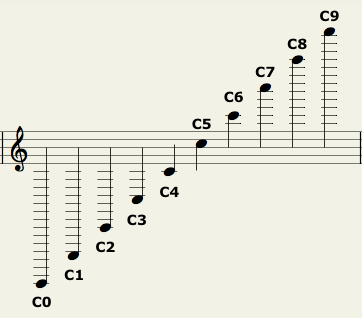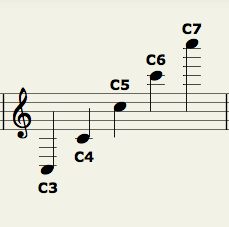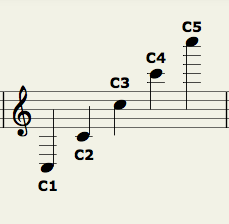Johnny wrote:My apologize stands for displaying my options and harsh comments.
Not about answering against the ill intended self-rewarding strife which I believe to have been focused at my comments about conventional methods used in modern notation.
Nothing I wrote was directed at you, but if you are as passionate about the marvels of "conventional methods used in modern notation" as I am opposed to them, then I fully understand how you could misunderstand my thoughts and quite mistakenly think that I was addressing you . . . 
If you examine my apparently offending post carefully, you will observe that it was
not a reply to you, where in contrast this post is a reply to something you wrote (
see the above quote) . . .
Other than being a bit temperamental, I think it is accurate to suggest that in this instance you are an innocent bystander . . .
Toward the goal of introducing a bit of clarity, (a) I expressed a bit of frustration in the "THOUGHTS" section of my earlier post and (b) I did
not cloak it completely, but so what . . .
So what!  OBSERVATION #1
OBSERVATION #1: Consider the topic: "Contrabass Playback" . . .
(1) This is one of the most difficult aspects of digital music production, and it is something that nearly no composers, musicians, and singers understand in any intuitively correct way. If they get it right, it is solely the consequence of serendipity. In particular for musicians and singers, the problem is that they quite mistakenly presume that because they are able to play an instrument proficiently or to sing skillfully, this somehow maps to their being experts in acoustic physics, producing, mixing, and mastering, when the factual reality is that cluelessness abounds, even when all the facts are known. I know this, because I suffered from this affliction until approximately three years ago when I had the required epiphany which occurs sometime after one begins the quest to discover why certain
Pop songs are loud without causing volume meters (LED or VU) to register much of anything . . .
This quest and its subsequent epiphany are fully documented in my ongoing topic in the IK Multimedia FORUM, which is fabulous . . .
The Fabulous Affordable Studio Monitor System Project (IK Multimedia FORUM)Fabulous! (2) The rules of acoustic physics--which are based on the fundamental rules of physics discovered and explained in the 17th century by Sir Isaac Newton--require a calibrated full-range studio monitor system for accurate contrabass playback, where "calibrated full-range" specifically refers to a flat equal loudness curve running from 20-Hz to 20,000-Hz (the range of normal human hearing) at 85 dB SPL, where it is better to extend the frequency range downward to 10-Hz in the subsonic bass range . . .
(3) The bass clef--transposing or otherwise--is one of many variables, but in the grand scheme of everything it does not provide the necessary solution without a calibrated full-range studio monitor system, because (a) accurately hearing deep bass and feeling subsonic bass in the digital music production universe only happens when music is played through a calibrated full-range studio monitor system and (b) without a calibrated full-range studio monitor system, one is doomed to spin wheels perpetually . . .
(4) For a variety of reasons, headphones will
not work for this purpose, primarily because (a) each ear hears something separate and independent from the other ear and (b) headphones do not move enough air to induce whole body tactile sensations . . .
OBSERVATION #2: Consider clefs and 12-tone Western music, where "Western" is
not referring to a musical genre like
Country Western or
Western Swing, but instead is used in its geographic definition . . .
(1) For all practical purposes, this is the factual reality, and it is mathematically and geometrically elegant:

(2) Becoming proficient in the range of C4 to C6 is not difficult, and extending it to C3 to C7 just requires a bit more work . . .

(3) There are 88 keys on a grand piano, 52 of which are white and 36 of which are black. Each key represents one unique note . . .
(4) A bright child can understand (2) and (3), and by inference (1) . . .
(5) As this applies to a contrabass with a C extension, it is logical to position the one true staff vertically so that C1 is readily available as its lowest convenient below staff note, but in a way that allows even lower notes, should they be desired . . .

(6) Done this way, (a) one needs to master only one clef; (b) one needs to understand that there are 12 notes and 8 or so octaves, some of which are high, some of which are low, and some of which are in the middle; and (c) one needs to understand the mapping of notes to music notation and the one true clef . . .
(7) It helps to understand that instruments and voices have ranges . . .
(8) It makes the following two sets of vastly confusing clefs frivolously counterintuitive:
[
NOTE: The first set of clefs was a bad idea conceived by a deluded cadre of people who likely were afflicted with obsessive-compulsive disorders. This bad idea was promoted to adored status due primarily to rampant pedantry during the times when doing anything with music was a rare luxury reserved for the wealthy and a few gifted peasants; and one of its most insidious consequences is that it hid the mathematical and geometrical elegance of music from the peasants, as was the general strategy regarding knowledge in general in those dark days. This nonsense confuses and discourages children by telling them a lie by inference, which specifically is that "Music notation is not FUN!", and it is nearly as bad as having a piano but not keeping it tuned. Musical instruments anywhere in the vicinity of children need to be maintained and tuned properly, because failing to do this results in deleterious pitch imprinting . . . ]

 THOUGHTS
THOUGHTSThis is
not the first time this topic has appeared, and it is unlikely that it will be the last time . . .
Moreover, as noted (
see above), I experienced the relevant affliction, but through diligent efforts I was able to clear the persistent obfuscation that prevents most people from having the required epiphany . . .
Secondarily, being able actually to hear deep bass and to feel subsonic bass is necessary when one is producing, mixing, and mastering in the digital music production universe . . .
Sixthly and lastly, a calibrated full-range studio monitor system with powerful deep bass subwoofers is required . . .
Thirdly, it is best to learn Barre chords when one is a guitar player and cannot avoid participating in musical groups with horn players . . .
And to conclude, none of this is your fault, which is fabulous . . .
Fabulous! 
P. S. Do a search of posts to this FORUM on "subwoofer", and you will discover that variations of this topic have appeared since October 2011, really . . .
[
NOTE: The subsonic and deep bass is present in the NOTION native sampled sounds, and this YouTube music video proves it with advanced scientific metering software, noting that this was done with NOTION 3, which was the case because even though as I recall NOTION 4 had been released, the MOTU folks had not released DIgital Performer 8, which provides 64-bit capability, so I was using Digital Performer 7, which is 32-bit only. The key analysis is in the lower-right corner (Fast Fourier Transform [FFT] analysis), where the x-axis is frequency and is logarithmic. The y-axis is amplitude, and it is logarithmic, as well. The meter at the lower-left is a phase analyzer, where in-phase notes are nearest to the vertical center line, and Pop songs tend to look like trees, where the kick drum and bass are the lower trunk and the midrange and high frequencies are the upper branches and leaves; and the top meter is an oscilloscope. Using an analogy, metaphor, or simile, the kick drum and bass are the earth, and all the other instruments and singers are flowers, where the rule is that having a lovely garden only happens when the flowers have somewhere to grow . . . ]
"I Want To Dance With You" (The Surf Whammys) -- CueMix FX Analysis, Basic Rhythm Section -- YouTube music video[
NOTE: I have been playing bass for over half a century, and I think this allows me to have a few thoughts on bass, eccentric as they might be. This YouTube music video was done before I discovered NOTION 3 and virtual instruments, so everything was done with real instruments here in the sound isolation studio, noting that I "borrowed" the idea for the "back-and-forth octaves" in the electric bass part from "Peer Gynt Suite: In the Hall of the Mountain King" (Edvard Grieg), which is whence Jimi Hendrix "borrowed it" for lead guitar on "Purple Haze" (The Jimi Hendrix Experience) . . . ]
"(I Want) Angela Gossow's Underpants (Ya-Ya-Ya)" (The Surf Whammys) ~ YouTube music videoReally! 
P. P. S. Special "Thanks!" to
DaddyO for a bit of gracious and sensible adult supervision, which is
much appreciated!





